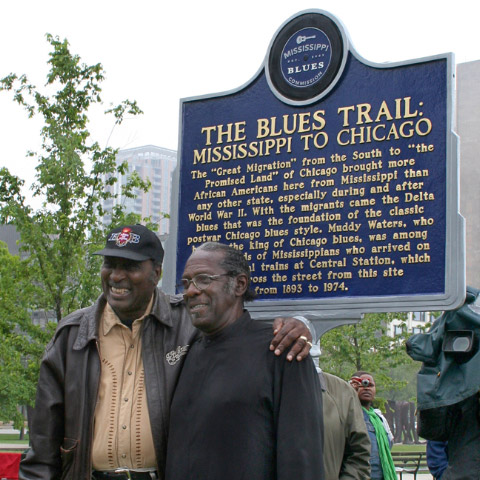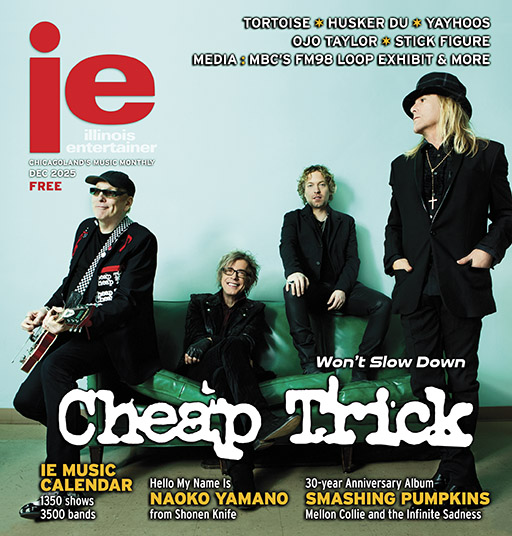December 2013: Sweet Home
 Eddy Clearwater and Eddie C. Campbell at the dedication in 2009
Eddy Clearwater and Eddie C. Campbell at the dedication in 2009
The Blues Trail
On the southern edge of Grant Park, overlooking empty train yards and trampled grass filled with dog walkers and soccer players, a piece of Chicago blues history stands, largely unnoticed. It’s hard to believe how few blues fans know where the Chicago marker on the Mississippi blues trail stand, so I took off to find it myself. It’s easy to overlook. Located directly across from the attention-grabbing “Agora” sculptures of headless iron torsos, the unassuming sign that announces the site as a Mississippi Blues Trail marker looks like a simple park placard or street notice. But it’s oh so much more.
The marker rests across the street from where the Illinois Central Railroad would stop, dropping off hundreds of African Americans who left the South for the North during the “Great Migration,”spanning 1915-1970. And what has that got to do with the Chicago blues? Everything. This was the spot where thousands of Mississippians arrived, including Muddy Waters, Jimmy Rogers, Howlin’ Wolf, Willie Dixon and Elmore James, bringing with them the Delta blues that they would transform into the Chicago blues. It’s the spot where their dreams of the storied North were first brought to reality by touching down in the Chicago IC train station.
There are two large stones from the Illinois Central station that remain near the Mississippi Blues Trail marker. Crumbling, but with the elaborate script that testifies to its one time importance, the stones echo the strong resolve those new migrants would need to demonstrate in order to survive in the big city. Lean against one of the stones and listen to the rushing traffic and hustling people. Imagine the loneliness, fear and isolation that those early migrants must have felt and you have the beginnings of what helped create the Chicago blues.
The blues has traveled a long way from the Mississippi Delta, literally and figuratively. The world honors the genre as the ultimate American folk music that launched nearly all popular American genres but we are still working on bestowing it with the proper respect and acknowledgement at home. The Chicago blues is such an integral part of the genre that the Mississippi Blues Trail includes Chicago as one of only a handful of markers out of state and one of only two located in the North.
Yet, few have come to visit the site since the marker’s unveiling five years ago. Bluesmen Eddy “The Chief” Clearwater and Eddie C. Campbell shared their experiences arriving in Chicago for the first time on the Illinois Central (IC) railroad from Mississippi during the 2009 dedication. Their speeches brought real life experiences, emotions and longings that they would eventually develop into their legendary careers performing Chicago blues.
The Mississippi Blues Marker celebrates the musicians, record label owners, DJs and club owners who helped create the Chicago blues. I hope that we continue to celebrate it and always remember the essential history of the blues. Please visit the Mississippi Blues Trail Chicago marker if you haven’t already. You can grab maps and apps for the whole trail at the blues trail website: http://bluestrail.org/blues-trail-markers/chicago. Here’s the inspiring text for the Chicago blues marker:
“The “Great Migration” from the South to “the Promised Land” of Chicago brought more African Americans here from Mississippi than any other state, especially during and after World War II. With the migrants came the Delta blues that was the foundation of the classic postwar Chicago blues style. Muddy Waters, who became the king of Chicago blues, was among the thousands of Mississippians who arrived on Illinois Central trains at Central Station, which stood across the street from this site from 1893 to 1974.
Robert Johnson never moved to the place he praised in his song “Sweet Home Chicago,” but his sentiments were shared by thousands of fellow Mississippi natives who came here in search of a better life. In “Chicago Bound,” bluesman Jimmy Rogers called the city “the greatest place around,” and in “Chicago Blues,” Arthur “Big Boy” Crudup deemed it “the greatest place on earth.” Many migrants traveled north on the Illinois Central via its extensive lines that spread across the Deep South, including eight hundred miles of IC-owned Yazoo and Mississippi Valley Railroad track that crisscrossed the Mississippi Delta.
Pullman porters on IC trains to Mississippi often delivered copies of the African-American newspaper, the Chicago Defender, which organized “migrant clubs” and arranged group discounts for train fare northward. The first wave of the “Great Migration” began with World War I, and between 1910 and 1920 the number of black Chicagoans who were born in Mississippi increased from 4,612 to 19,485.
The rise of the blues recording industry in Chicago attracted many musicians, and during the 1930s, blues artists here who claimed Mississippi roots included Willie Dixon, Memphis Minnie, Lil Green, and Big Bill Broonzy. During World War II the need for factory labor helped fuel a larger wave of migration, and between 1940 and 1950 some 150,000 Mississippians moved here. Muddy Waters, Howlin’ Wolf, Bo Diddley, Jimmy Reed, Sunnyland Slim, Emore James, Sonny Boy Williamson, No. 2 (Rice Miller), Otis Rush, and Magic Sam were among the many who arrived in the 1940s and ’50s and found recording opportunities with Chess, Vee-Jay (co-founded by Mississippi native Vivian Carter) Records, Cobra, and other labels. Blues clubs proliferated on the South and West sides, and Chicago’s airwaves also took on a down-home Mississippi flavor on programs hosted by Pervis Spann of WVON and Al Benson of WGES, who earned the honorary title “Mayor of Bronzeville” as the South Side’s most popular personality.
Local labels Delmark and Testament began recording blues albums in Chicago for a new generation of listeners in the 1960s, paving the way for other companies such as Alligator and Earwig. Albums by Mississippi-born bluesmen Big Joe Williams, Jimmy Dawkins, Carey Bell, Honeyboy Edwards, Big Walter Horton, Eddy Clearwater, Eddie Shaw, Magic Slim, Fenton Robinson, Eddie C. Campbell, and Hound Dog Taylor brought their music to world-wide attention. Foreign tourists made Chicago a musical destination, and the local blues audience adopted “Sweet Home Chicago” as its theme song as the blues expanded to the North Side, the suburbs and here to Grant Park, where the world-renowned Chicago Blues Festival debuted in 1984.
– Rosalind Cummings-Yeates
Category: Columns, Monthly, Sweet Home












Nice tribute to the Mississippi bluesmen who moved North, spreading the gospel of the blues. For those who want to see where they came from, please come visit us in the Mississippi Delta. The “Mississippi Blues Trail” has nice web site at http://www.msbluestrail.org plus a excellent phone app you can pick up through your app store for FREE.